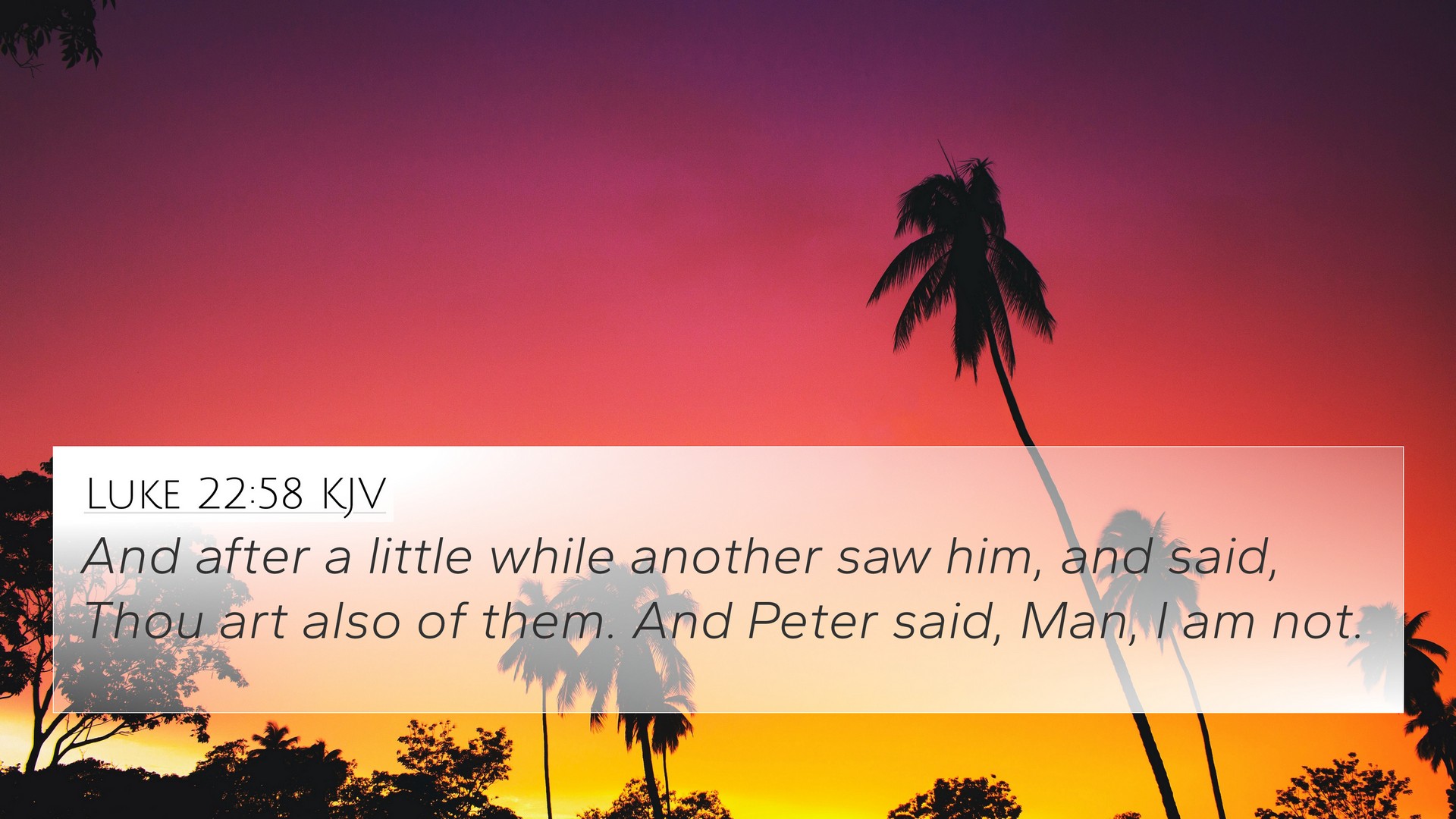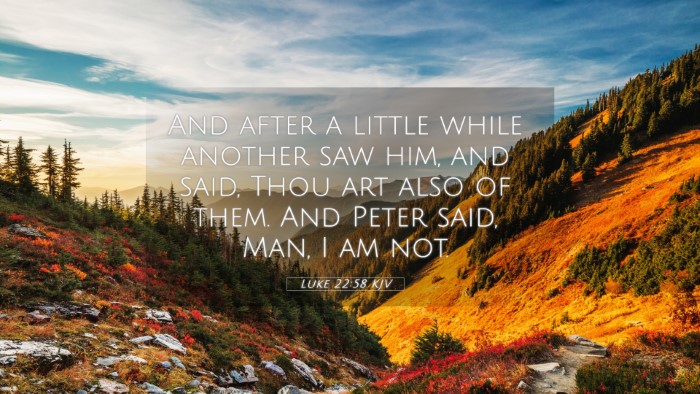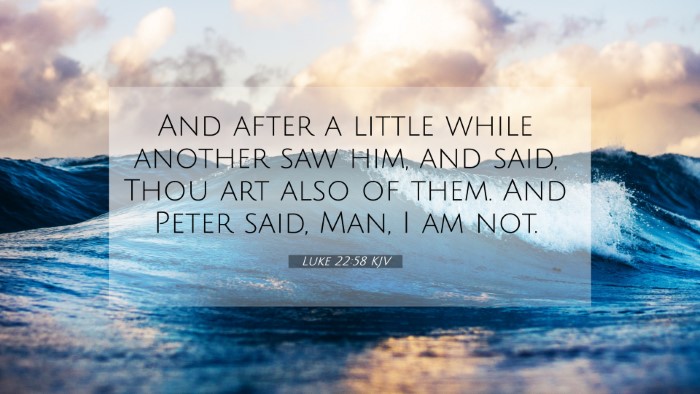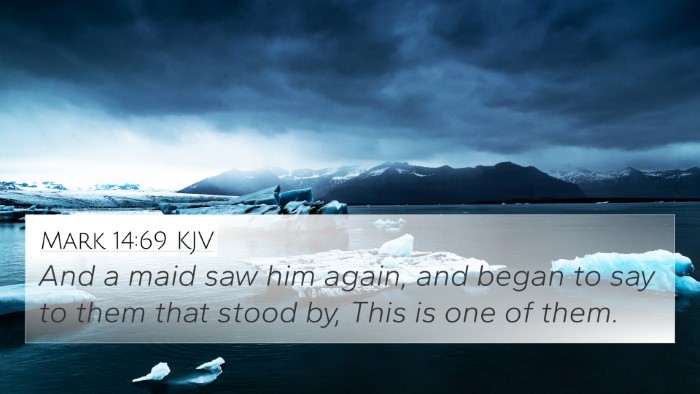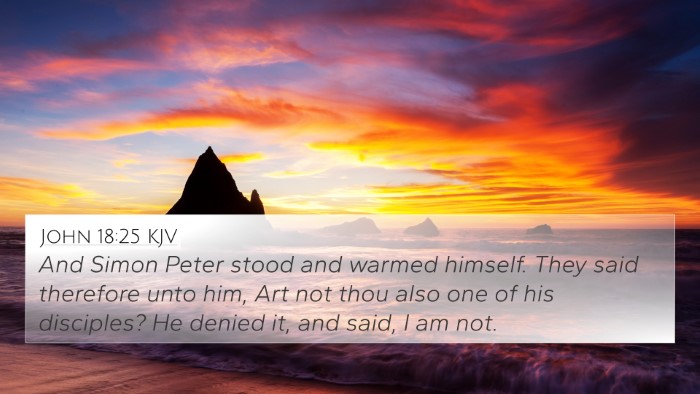Understanding Luke 22:58
Luke 22:58 states: "And after a little while another saw him and said, Thou art also of them. And Peter said, Man, I am not." This verse captures a crucial moment in the narrative of Peter's denial of Jesus. It is part of the broader context of Jesus's trial and Peter's struggle with fear and pressure.
Contextual Overview
In the preceding verses, Jesus is being led away to be tried, and Peter has followed at a distance. Here, Peter faces questioning from the onlookers, who recognize him as one of Jesus's followers. This moment reflects his internal conflict—his loyalty to Jesus is overshadowed by fear of association with Him amidst the dangerous atmosphere surrounding Jesus's arrest.
Commentary Insights
- Matthew Henry: Henry emphasizes the significance of Peter's denial, noting that it reveals the frailty of human conviction in the face of opposition. Peter's bravado earlier (in the garden) was quickly diminished when confronted with the reality of persecution. This verse showcases how, even the most devoted can falter under pressure.
- Albert Barnes: Barnes points out the guilt Peter must have felt. He relates this moment to the larger theme of redemption, hinting that even after failure, forgiveness is possible through Christ. Peter's denial is a stark reminder of the importance of remaining steadfast in faith, particularly when under scrutiny.
- Adam Clarke: Clarke provides insight into the profound nature of Peter's denial, highlighting the specific context of speech and identification. He suggests that Peter's reaction symbolizes the struggle every follower of Christ faces when their faith is challenged publicly. Clarke echoes the sentiment that this moment sets the stage for Peter's later restoration by Jesus post-resurrection.
Bible Verse Cross-References
Luke 22:58 connects thematically with several other Bible verses that explore courage, denial, and redemption. Here are key cross-references:
- Matthew 26:74-75: Matthew's account of Peter's denial emphasizes the moment of realization and remorse after the rooster crows, paralleling Luke's narrative.
- Mark 14:70-72: Mark's Gospel provides a similar story, making the details of Peter's denial vivid and impactful.
- John 18:25-27: John's recounting of the same scenario adds depth to Peter's identity as a disciple, revealing the personal struggle.
- Luke 22:61: Just after Luke 22:58, this verse depicts Jesus turning and looking at Peter, which evokes a moment of profound sorrow and realization.
- Luke 22:32: Earlier in the passage, Jesus tells Peter that He has prayed for him, highlighting that even in our failings, Christ intercedes for us.
- John 21:15-19: Following His resurrection, Jesus restores Peter, emphasizing themes of forgiveness and restoration after denial.
- 1 Peter 5:8-10: Later in life, Peter urges others to stand firm in their faith, reflecting on his own experience as a cautionary tale.
- Galatians 2:11-14: Paul speaks of Peter’s later hypocrisy, illustrating the ongoing struggle of maintaining authenticity in faith.
- Romans 5:8: This verse reinforces that despite our shortcomings, God’s love is unwavering and unconditional.
- Isaiah 53:6: The prophecy captures the essence of human failings and the need for redemption, connecting both the Old and New Testament themes.
Thematic Connections
The themes present in Luke 22:58 can be explored through various inter-Biblical dialogues:
- Fear versus Faith: Peter's denial exemplifies the tension between fear of man and faith in God.
- Repentance and Restoration: This moment foreshadows Peter's later repentance and Christ’s forgiveness, setting a precedent for all believers.
- Identity in Christ: Peter's struggle with his identity as a follower of Jesus illustrates the broader struggle many face in affirming their faith amidst societal pressure.
- Courage in Trials: The narrative challenges believers to display their faith boldly, even when faced with adversity.
Application for Today
Luke 22:58 serves as a powerful reminder of the human condition and the common struggle with faith under pressure. It encourages believers to:
- Reflect on personal faith during difficult times.
- Seek repentance and understand the grace offered through Christ.
- Encourage one another in faith communities, recognizing that fear can threaten one’s faith commitments.
- Engage in deep study of scripture to understand the connections between verses and their implications for one’s faith journey.
Conclusion
Luke 22:58 encapsulates a significant moment of weakness in one of Jesus’s closest disciples, revealing profound truths about human frailty, the call to be faithful, and the grace of redemption. By utilizing tools for Bible cross-referencing, such as a Bible concordance or cross-reference Bible study methods, believers can deepen their understanding of scripture and explore the rich tapestry of connections between Bible verses that support and illuminate each narrative.
In the study of Luke 22:58 and its surrounding passages, believers are encouraged to see the interplay between fear and faith, the reality of human shortcomings, and the unwavering call to restoration through Christ. By engaging in comparative Bible verse analysis, one can appreciate the complexity of Biblical texts and how each verse relates to others, forming a cohesive understanding of overarching Biblical themes.
